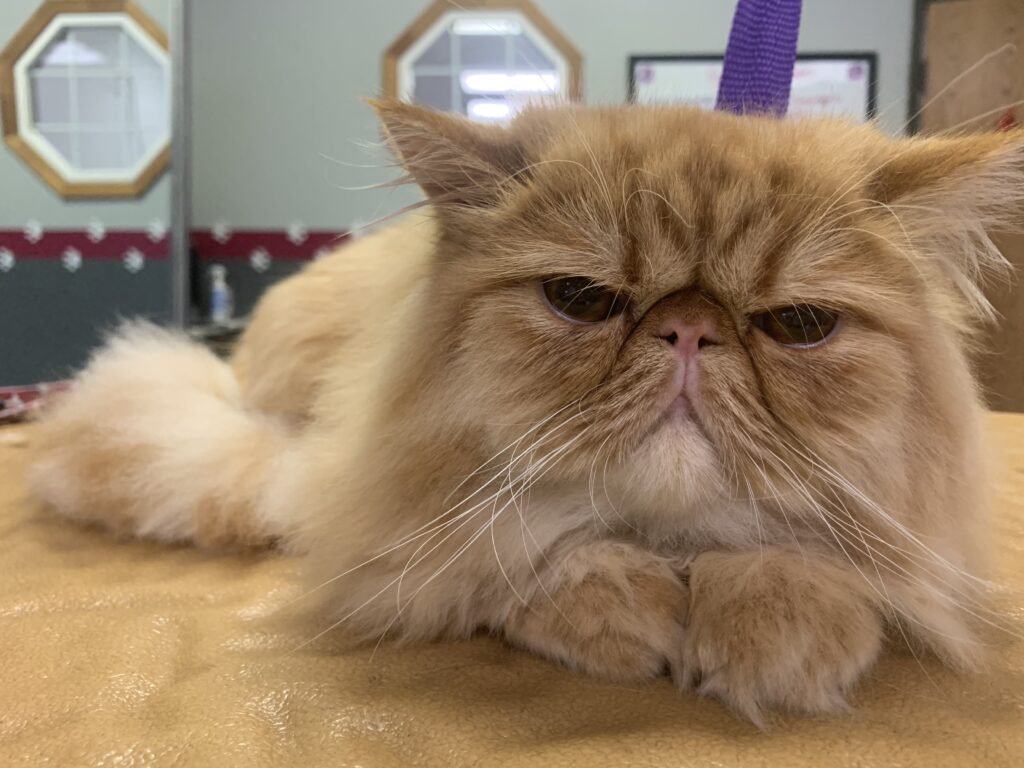Cats are so great at cat grooming that we sometimes think they don’t need regular baths or brushing. Cats instinctively groom themselves to banish any odors that may be noticed by other animals, especially predators. They are also able to maintain a healthy-looking coat by daily grooming and distributing natural oils to keep their coats clean and shiny.
While cats do a good job with basic grooming on their own, there are a few things that they need your help with. There are checks that you can do at home to ensure that your pet is healthy and happy. These include:
- Weekly flea checks
- Brushing out mats in their fur before they become unmanageable
- Checking your cat’s paws are healthy
- Look for irregularities of the skin or eyes
- Attend to any problems by scheduling a vet appointment
From nail trims to bathing, a little maintenance goes a long way. Regular grooming appointments can help keep your kitty’s eyes, ears, teeth, skin, and fur healthy and clean. Read on to find out more.
How Do I Know My Cat’s Regular Grooming Needs?
Frequency and type of grooming vary depending on your cat’s breed and coat.
Long-Haired Cat Grooming
Certain breeds and mixed breeds with long, dense coats benefit from regular bathing, which can help cut down on matting. Brushing and combing for these breeds is also important, but the cleaner the coat is, the less it will tangle and mat. Birmans, Maine Coons, Norwegian Forest Cats, Persians, Himalayans, Ragdolls, and Siberians, for example, all have long, thick coats that require frequent brushing and regular bathing. Long-haired cats should receive a bath, dry and comb out every 8 weeks to keep the coat from getting matted. If the cat’s coat mats easily they may need more frequent appointments to keep them in full coat.
Silky or Short-Haired Cat
Some cat coat types like silky or short hair are less likely to mat, and therefore don’t require as much grooming. Generally, silky-haired cats like Bengals, Burmese and Siamese tend not to tangle as much, because they have short coats with very little undercoat. However, short-haired cats can still benefit from occasional bathing, which will remove dirt, saliva, excess oils and dander. Not only will the coat look, smell and feel fantastic, but bathing your cat might even provide less shedding. The brushing frequency for silky or short-haired cats depends on their coat. If they tend to mat easily, they may require daily brushing. Other cats are fine with brushing a few days a week. Short-haired cats aren’t always low maintenance, however. Some short-haired cats have dense coats that benefit from regular bathing and brushing to eradicate excessive shedding, hairballs, and mats.
Hairless Cat
Even hairless cat breeds aren’t exempt from baths! In fact, they need a regular bathing routine. Hairless cat breeds can leave an oily residue on clothing, bedding, and other fabrics if you don’t bathe them every week.
Other Cat Grooming Needs
In addition to bathing and brushing, your groomer can help you keep your pet in good health in these ways:
Ear Care
Cats aren’t able to maintain their ear care well on their own. A cat groomer will check the inner and outer ear to make sure it’s clean while making note of any signs that may require medical attention from a veterinarian such as bald spots, redness, bleeding, discharge, debris, caked ear wax, swelling, or odor.
Hair Trimming
Some long-haired cats grow fur between their toes and that can aggravate your pet, increase litter box debris, or even affect their traction. Groomers can trim this hair if necessary at their cat grooming appointment.
Groomers give your cat what is called a “sanitary trim”. This entails trimming the fluffy hair around sanitary areas to help keep those areas free of bodily waste. Bodily wastes deposited on pet fur pose a sanitary risk to your pet, family, and home. The trim also provides adequate ventilation of these areas so that the risk of bacteria is lessened.
Nail Trimming
Cats need healthy feet to scratch and climb. That’s why it’s important to regularly examine and clean your cat’s paws and check their claws. If your cat’s claws are long, curved, and razor sharp, they’re ready for a trim. For your cat, clipping their claws prevents painful broken claws that result when sharp nails that get caught in the carpet or other surfaces. Your cat’s nails can be trimmed as a walk-in or will be done during grooming.

